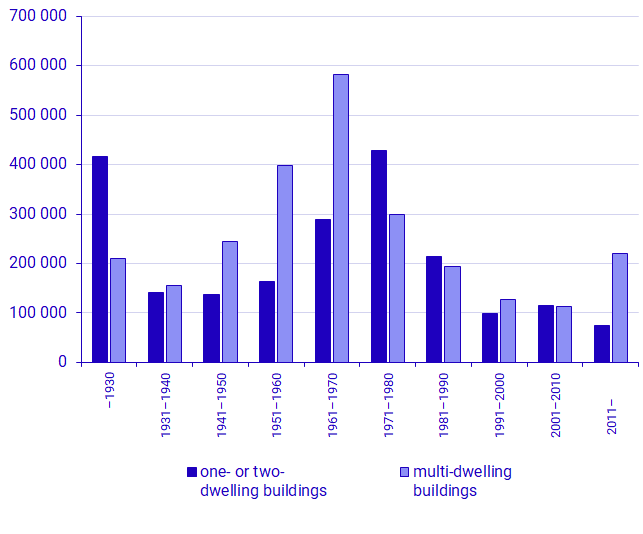Dwelling stock 2019-12-31
Nearly 5 million dwellings in Sweden
Statistical news from Statistics Sweden 2020-04-23 9.30
At the end of December 2019 there were 4 978 239 dwellings in Sweden. Among these, 2 087 965 dwellings (42 percent) were in one- or two-dwelling buildings, 2 548 530 (51 percent) were in multi-dwelling buildings, 260 406 (5 percent) were in special housing and 81 338 (2 percent) were in other buildings.
Rented dwellings most common in 257 out of 290 municipalities
In multi-dwelling buildings, rented dwellings are the most common type of tenure, with 58 percent of the total dwelling stock, while 42 percent consist of tenant-owned dwellings. Among the 290 municipalities in Sweden, rented dwellings dominated in 257 municipalities. Only in 33 municipalities are there more tenant-owned dwellings than rented dwellings and 20 of these are located in Stockholm County.
Among the 10 largest municipalities, rented dwellings dominated in seven of them, while only two municipalities - Uppsala and Stockholm - had more tenant-owned dwellings than rented dwellings. In Västerås municipality, the proportions were evenly distributed between rented dwellings and tenant-owned dwellings.
| Municipalty | Share of rental units | Share of tenant-owned units |
|---|---|---|
|
Örebro
|
78 | 22 |
|
Norrköping
|
69 | 31 |
|
Linköping
|
67 | 33 |
|
Helsingborg
|
64 | 36 |
|
Jönköping
|
63 | 37 |
|
Göteborg
|
62 | 38 |
|
Malmö
|
52 | 48 |
|
Västerås
|
50 | 50 |
|
Stockholm
|
43 | 57 |
|
Uppsala
|
37 | 63 |
In one- or two-dwelling buildings, private ownership is the most common type of tenure, at 91 percent. Rented dwellings and tenant-owned dwellings in one- and two-dwelling buildings each account for 4 percent.
Housing cooperatives most common owners of multi-dwelling buildings
With regard to dwellings in multi-dwelling buildings, 42 percent are owned by housing cooperatives, 27 percent are owned by municipal housing companies and 21 percent are owned by Swedish joint-stock companies. The remaining 10 percent are owned by private persons and other owners.
With regard to one- or two-dwelling buildings, the vast majority (91 percent) are owned by private persons. Four percent are owned by housing cooperatives and municipal housing companies and Swedish joint-stock companies each own two percent.
Dwellings’ size and age
The average dwelling in multi-dwelling buildings is a flat with two rooms and a kitchen, followed by three rooms and a kitchen. These two types make up 68 percent of the housing stock in multi-dwelling buildings.
The average size of a dwelling in multi-dwelling buildings is 68 square metres, while in one- or two-dwelling buildings, the average size is 122 square metres.
| Dwelling size | Number of dwellings | Share in percentage |
|---|---|---|
|
Dwellings without kitchen
|
1 710 | 0.1 |
| 1 room and kitchen | 295 622 | 11.6 |
| 1 room and kitchenette | 116 594 | 4.6 |
| 2 rooms and kitchen | 929 308 | 36.5 |
| 2 or more rooms with kitchenette | 46 166 | 1.8 |
|
3 rooms and kitchen
|
799 513 | 31.4 |
|
4 rooms and kitchen
|
281 106 | 11 |
|
5 rooms and kitchen
|
55 255 | 2.2 |
|
6 or more rooms and kitchen
|
11 213 | 0.4 |
|
Data missing
|
12 043 | 0.5 |
|
TOTAL
|
2 548 530 | 100 |
Nearly 932 000 (45 percent) one- or two-dwelling buildings were built between 1961 and 1990. However, one in five one- or two-dwelling buildings (20 percent) was built as early as before 1931.
With regard to multi-dwelling buildings, 1 277 000 dwellings (50 percent) were built between 1951 and 1980.

Special housing
There are 260 406 dwellings in total in special housing, consisting of 138 277 special housing for the elderly/disabled, 102 664 dwellings for students, and 19 465 other special housing. The average size of an apartment in a retirement home is 39 square metres, while the average size of a student apartment is 28 square metres. Naturally, most student housing is found in the major university towns.
Municipality |
Number of dwellings |
|---|---|
Uppsala |
11 463 |
Stockholm |
11 308 |
Göteborg |
11 148 |
Lund |
9 760 |
Umeå |
6 305 |
Linköping |
5 099 |
Växjö |
3 943 |
Örebro |
3 696 |
Definitions and explanations
These statistics are based on the dwellings register, which is a national register of all dwellings in Sweden. This register is managed by Lantmäteriet (the Swedish mapping, cadastral and land registration authority). Statistics Sweden receives data from Lantmäteriet for the production of current household and housing statistics.
Dwellings refers to a flat intended fully or to an appreciable proportion as a place of residence, regardless of the type of building in which it is located. Dwellings in one- or two-dwelling buildings are therefore also defined as flats.
One- or two-dwelling buildings refers to detached one- and two-dwelling buildings, as well as semi-detached, row and linked buildings.
Multi-dwelling buildings refers to buildings with three or more apartments, including balcony access housing.
Other buildings refers to buildings that are not intended for residential purposes, but that nonetheless contain regular apartments, for example buildings intended for business or public activities.
Special housing refers to dwellings for the elderly/disabled, student housing and other special housing.
The type of tenure of the apartments is based on ownership, rather than residents’ use of the apartments.
Feel free to use the facts from this statistical news but remember to state Source: Statistics Sweden.
